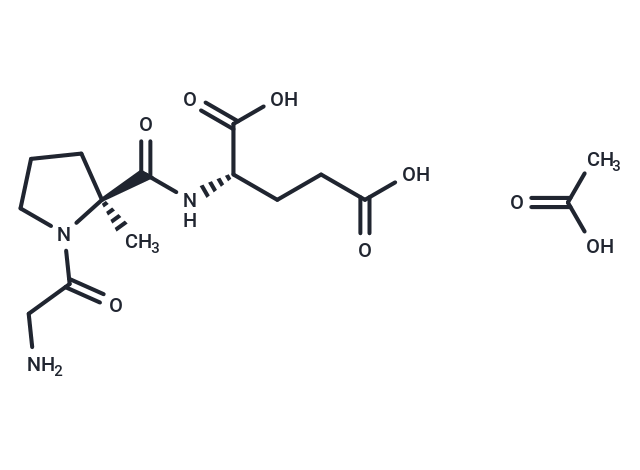- Remove All
 Your shopping cart is currently empty
Your shopping cart is currently empty
Trofinetide acetate
Trofinetide, derived from the neuroprotective tripeptide Gly-Pro-Glu (an N-terminal sequence of insulin-like growth factor-1, IGF-1), shows promise in various neuroprotective models. At a concentration of 10 nM, it mitigates cell death in primary rat embryonic striatal neurons caused by okadaic acid. Additionally, Trofinetide reduces the expression of pro-inflammatory markers (IL-1β, TNF-α, IL-6, and E-selectin) in a rat model simulating neuroinflammation from penetrating ballistic-like brain injuries. In cases of brain injury induced by middle cerebral artery occlusion (MCAO), administration of Trofinetide at 30 and 60 mg/kg reduces the area of cortical and striatal infarct. Furthermore, a daily dose of 100 mg/kg reverses social recognition and contextual fear conditioning deficits, diminishes the number of dendritic spines, and decreases testicular weight gain in an fmr1-/- knockout mouse model of fragile X syndrome. Trofinetide formulations have been employed in treating Rett syndrome, highlighting its versatility across various neurological conditions.

Trofinetide acetate
| Pack Size | Price | Availability | Quantity |
|---|---|---|---|
| 25 mg | Inquiry | 3-6 months | |
| 50 mg | Inquiry | 3-6 months | |
| 100 mg | Inquiry | 3-6 months |
Product Introduction
| Description | Trofinetide, derived from the neuroprotective tripeptide Gly-Pro-Glu (an N-terminal sequence of insulin-like growth factor-1, IGF-1), shows promise in various neuroprotective models. At a concentration of 10 nM, it mitigates cell death in primary rat embryonic striatal neurons caused by okadaic acid. Additionally, Trofinetide reduces the expression of pro-inflammatory markers (IL-1β, TNF-α, IL-6, and E-selectin) in a rat model simulating neuroinflammation from penetrating ballistic-like brain injuries. In cases of brain injury induced by middle cerebral artery occlusion (MCAO), administration of Trofinetide at 30 and 60 mg/kg reduces the area of cortical and striatal infarct. Furthermore, a daily dose of 100 mg/kg reverses social recognition and contextual fear conditioning deficits, diminishes the number of dendritic spines, and decreases testicular weight gain in an fmr1-/- knockout mouse model of fragile X syndrome. Trofinetide formulations have been employed in treating Rett syndrome, highlighting its versatility across various neurological conditions. |
| Alias | NNZ-2566 |
| Molecular Weight | 315.32 |
| Formula | C13H21N3O6.XC2H4O2 |
| Storage | keep away from moisture | Powder: -20°C for 3 years | In solvent: -80°C for 1 year | Shipping with blue ice. | |||||||||||||||||||||||||||||||||||
| Solubility Information | Ethanol: 1 mg/mL (3.17 mM), Sonication is recommended. PBS pH 7.2: 10 mg/mL (31.71 mM), Sonication is recommended. DMSO: 10 mg/mL (31.71 mM), Sonication is recommended. DMF: 5 mg/mL (15.86 mM), Sonication is recommended. | |||||||||||||||||||||||||||||||||||
Solution Preparation Table | ||||||||||||||||||||||||||||||||||||
Ethanol/DMF/PBS pH 7.2/DMSO
DMF/PBS pH 7.2/DMSO
PBS pH 7.2/DMSO
| ||||||||||||||||||||||||||||||||||||
Calculator
In Vivo Formulation Calculator (Clear solution)
Dose Conversion
Tech Support

Copyright © 2015-2025 TargetMol Chemicals Inc. All Rights Reserved.




